How should a sports bra fit? This is a common question from women looking to properly support their breasts during exercise.
If you’re a woman, you may know the pitfalls of exercising without a supportive bra.
From the pain and discomfort to the bouncing and chafing, it can feel uncomfortable and downright embarrassing to go for a run.
And it seems you’re not alone in feeling like this.
According to research from the University of Woolagong Australia, given the benefits of exercise, many females refrain from physical activity due to the pain and/or embarrassment associated with excessive breast motion.
Adding that approximately 50% of females report suffering exercise-induced breast discomfort during physical activity.
Their research also highlighted that ‘bra discomfort’ was ranked as one of the highest perceived barriers to exercise in women living with a diagnosis of breast cancer.
So how should a sports bra fit? How best can you support your breasts during running using a sports bra? How can you find the right sports bra?
In this guide we’ll explore:
- Breast movement during running explained
- What are the risks of running without a sports bra?
- How to find the right sports bra for running
- High support vs low support bras
- Signs you are wearing the wrong bra size
- How to measure bra size
- How should a sports bra fit? 7 step checklist
- Running wearing a sports bra Q&A
- The best high support sports bras for running
Ready?
Let’s get going!
Before we get started, thanks to adidas for sponsoring this post!
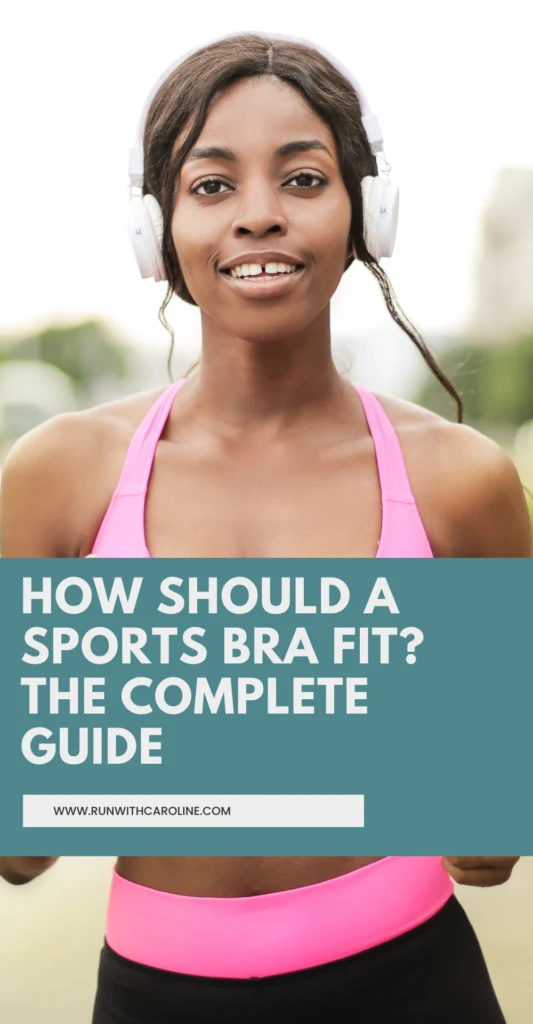
Breast movement during running explained
Similar to walking, running is referred to as a ‘locomotive activity’.
Running requires greater balance, muscle strength and joint range of movement compared with walking.
It’s also a high impact sport.
Different impact levels refer to the effect of the activity might have on your body.
You might already know that in the case of running shoes, for example, impact refers to the strain that it can cause to weight-bearing joints like ankles, knees and hips.
When it comes to sports bras, impact refers to the effect the activity may have on your breasts.
The higher the impact level, the greater degree of breast movement which means the greater need you will have for proper support.
Research found that your breasts move an average of 9cm (3.5 inches) during moderate exercise and can move up to 15cm (6 inches) during high intensity exercise.
Contrary to popular belief, breasts not only move up and down (50% of the time), but side to side (25% of the time) and backwards and forwards (25% of the time) too.
The average D cup can weigh between 4 to 5 pounds.
So depending on your breast size, this means you can be carrying around extra pounds when you run – all of which needs to be properly supported.
Unfortunately, the body isn’t that great at supporting breasts.
Unlike other parts of your body, there isn’t any muscle or bone in the breasts to keep them stabilised and immobilised, just tissue.
So they are more susceptible to pain and discomfort during excessive movement.
As we explain later in this guide, a well-fitted, supportive sports bra is a must for running.
Related: Moisture wicking underwear: Benefits + where to buy
What are the risks of running without a sports bra?
There are risks associated with running without a sports bra, or indeed with a poorly fitted sports bra.
It’s important to note that all these risks can be mitigated by wearing a well-fitted, supportive sports bra.
In fact, wearing a sports bra is one of the best things you can do to prevent problems associated with breast movement during exercise.
If you wear a poorly fitted bra that does not support your breasts in the right way, you may encounter the following issues.
#1 Pain and discomfort
Breast movement during exercise can cause pain and discomfort, as well as lead to long term problems such as sagging breasts.
By not wearing a supportive bra, you risk damaging ligaments that may result in long-term mobility issues such as back pain or shoulder pain.
Big breasts can also cause back pain as the weight of your breasts pulls your trunk forward, which can cause you to hunch over.
Many women experience tender and sensitive breasts in the days leading up to their period.
If the pain is severe enough, you may want to skip your run and focus on a low impact workout instead.
#2 Chafing
If your bra does not fit properly, it can cause your breasts to move excessively.
The more your bra and breasts move during your run, the more chafing you will experience.
There are ways to combat this by applying anti-chafing cream in sensitive areas like under your arms.
The best option, however, is to wear a well-fitted bra in the first place.
Even better if it has sweat-wicking properties, it will help to minimise chafing.
#3 Bouncing
If you don’t lock your breasts down by wearing a well-fitted sports bra, you will likely experience excessive breast bouncing.
A high support bra will eliminate bouncing by about 50%.
The goal is for the breasts to move in unison with your torso and not bounce independently of one another.
Related: How to get rid of side boob fat: 4 things you can do
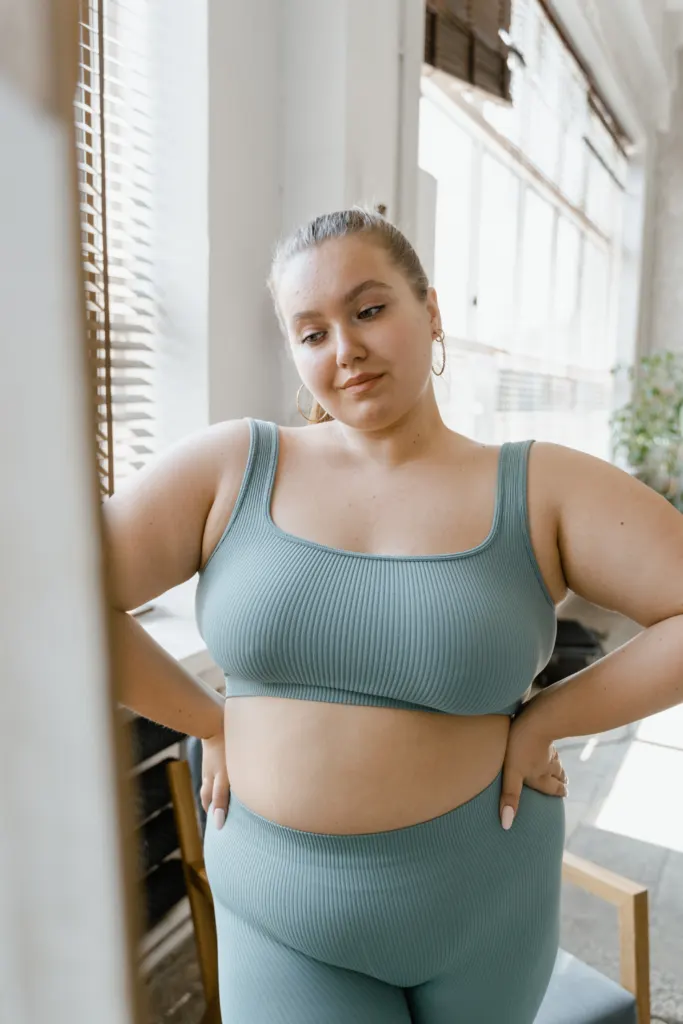
Related: The ultimate guide to running backpacks for women
How to find the right sports bra for running
The right sports bra should feel comfortable, fit properly and provide adequate support.
A poorly fitted bra can have negative impacts for your posture and running form.
It can also contribute to musculoskeletal pain and create imbalances in your kinetic chain.
Surprisingly, over 85% of women wear the wrong size bra!
High support vs low support bras
A 2015 study looked at the effect of breast support and breast pain on upper-extremity kinematics during running.
The high support bra used in the study, compared with the low support bra, reduced breast kinematics and decreased breast pain.
The bottom line? Wearing a high support bra during running can help to minimise pain and discomfort.
Here are the key differences between high support and low support bras.
High support bra
- Provides high levels of support.
- Designed for activities that involve a lot of jumping or bouncing (e.g. running, sprinting, HIIT, boxing, dancing).
- Has some or all of the following features: molded cups, control levels, underwires, adjustable and padded straps and multiple hooks.
Low support bra
- Provides lower levels of support.
- Designed for activities that involve low degrees of bouncing (e.g. walking, yoga, Pilates, cycling, lounging around the house).
Related: How to stop vaginal chafing when running
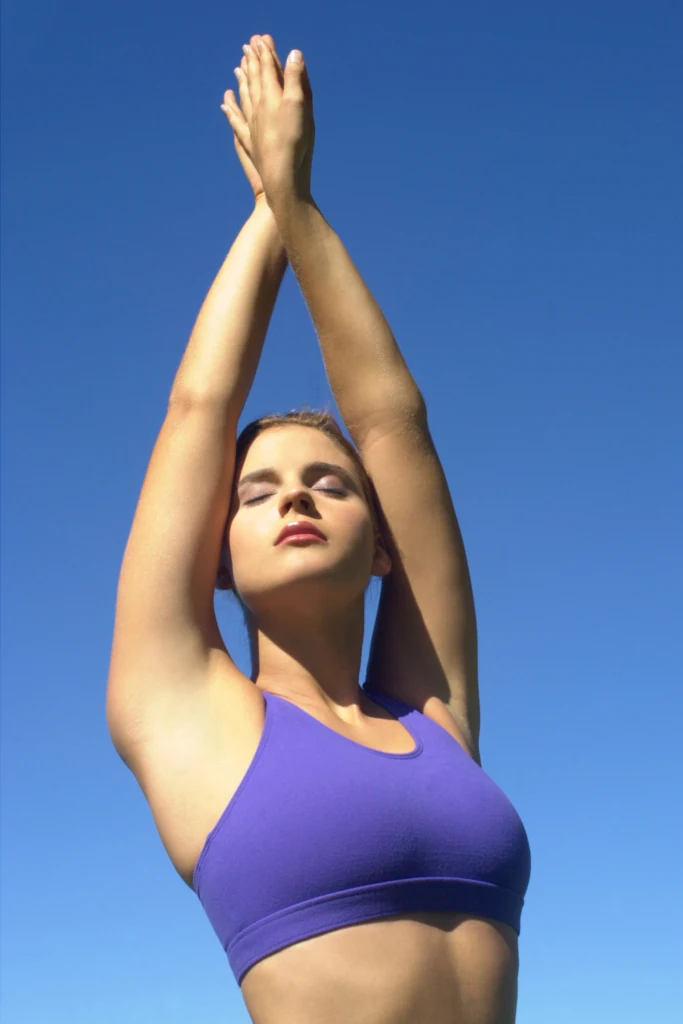
Signs you are wearing the wrong bra size
Here are a few common signs that you are wearing the wrong bra size.
Bear in mind that certain factors like weight gain or loss and pregnancy could cause you to change bra size.
- Underwire poking the sides of your boobs
- Straps that don’t stay put and slip down your shoulders
- A band that rides up your chest
- Cup spillage
- Wrinkling in the cups
- A bra that rides up when you lift your arms
Related: Running for weight loss: The most effective running workouts
How to measure bra size
There is a simple 3-step process to work out your bra cup size.
Step 1: Measure your bra band size
The bra band is the band that runs around your torso directly under your breasts.
You will need a tape measure to do this. The tape should be snug around your torso when you measure.
Round to the nearest whole number, then add 4 inches (if the number is even) or add 5 inches (if the number is odd).
For example, if you measured 32 inches, your band size will be 36 inches. Whereas if you measured 33 inches, your band size is 38 inches.
Step 2: Measure your bust size
Now wrap the tape measure around the fullest part of your chest (at the nipple level).
Round to the nearest whole number.
Step 3: Calculate your bra cup size
You’ll now need the measurements you took in step 1 and 2 to work out your bra cup size.
Subtract your band size (step 1) from your bust size (step 2) and refer to the bra cup size chart below.
For example:
37 inches (bust size) minus 34 inches (band size) equals 3 inches (which means a bra cup size of 34C.
Bra size chart
| Difference (inches) | 0 | 1 | 2 | 3 | 4 | 5 | 6 | 7 |
| Cup size (inches) | AA | A | B | C | D | DD | DDD, F | G |
Related: How to fix a saggy butt: 5 exercises to lift your butt
How should a sports bra fit? 7 step checklist
Here’s a checklist for what to think about when trying on a sports bra:
#1 Control
Check the bra has the appropriate control level. The larger your breasts, the more control you’ll want, regardless of activity type.
#2 Size
Check the bra fits your breasts properly. A bra that is too big or too small will cause discomfort and chafing.
#3 Band
Check the bra has a thick, supportive and elasticated band that wraps all the way around parallel to the ground.
It shouldn’t feel uncomfortably tight – you should be able to fit two fingers underneath the strap, but no more.
#4 Adjustable hook and closure
Check the bra has an adjustable hook and closure mechanism as this will provide more flexibility in terms of fit.
Make sure the bra fits properly on the first and last hook.
#5 Straps
Check the bra has wide, cushioned shoulder straps.
These are ideal, especially for women with large breasts, because thin straps can dig into and pinch the shoulders.
Make sure they are adjustable – again you should be able to fit two fingers underneath them.
#6 Underwires
Check the bra has a cushioned underwire. An underwire will provide extra support.
Make sure the underwire sits on top of your ribcage under your breasts and not on top of them.
#7 Molded cups
Check the bra has molded cups. These cups are best for support and limiting movement.
They’re also much more flattering than a flat-look bra.
Make sure your breasts are not spilling out of them, and also check you don’t have any gaps.
If there’s spillage, you need a bigger cup size. If there are gaps, you need a smaller cup size.
Related: 7 of the best websites to buy affordable running clothes
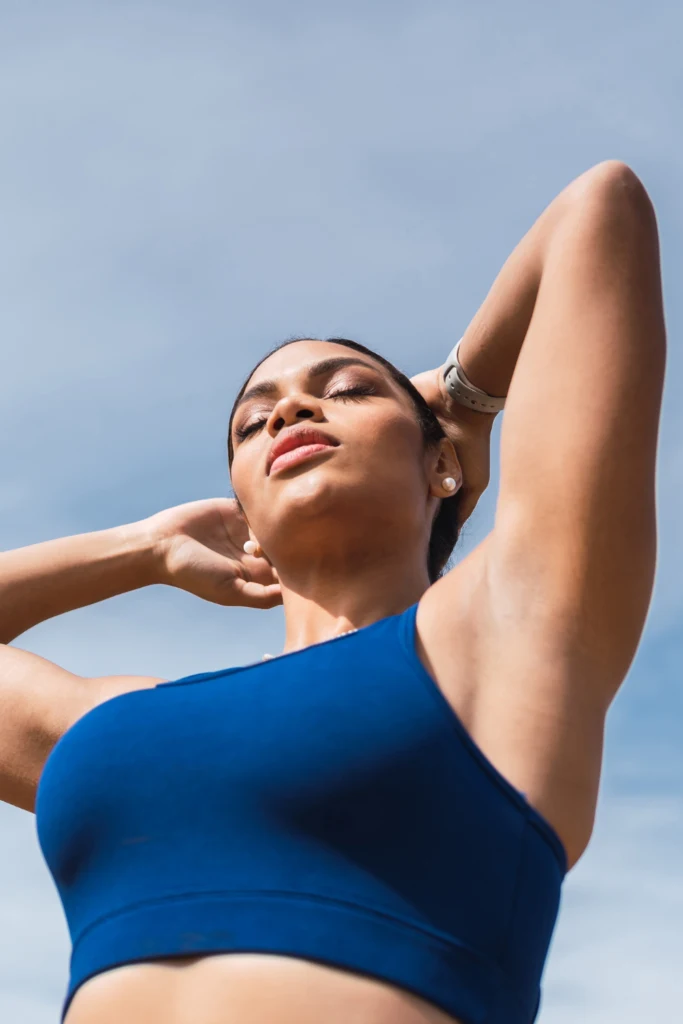
Running wearing a sports bra Q&A
Q: Is breast movement impacted by running pace?
A: Research tells us that breast movement is not impacted by running pace.
So if you’re running at a 10 minutes per mile pace, your breasts will be moving at their maximal displacement.
Running at a 7 minutes per mile pace means they won’t move any more than that.
The bottom line? You need a high support bra all of the time, no matter whether you’re going for a long, slow run or a high intensity speed training session.
Q: Is breast movement impacted by breast size?
A: Breast movement is not impacted by breast size.
However, if you have larger breasts, you have extra weight to contend with which can cause greater pain and discomfort.
You should always wear a supportive sports bra when working out, no matter your breast size.
By not wearing a sports bra, you could potentially risk damaging ligaments that may result in long-term mobility issues such as back pain or shoulder pain.
Related: Should you work out on your period? 6 best exercises
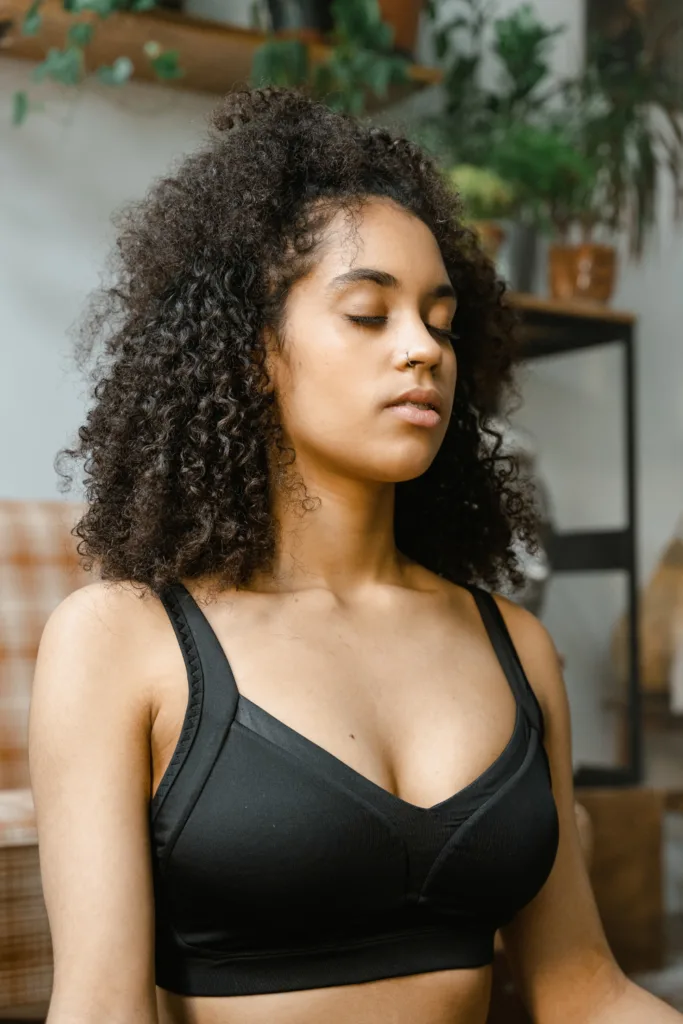
The best high support sports bras for running
Many brands nowadays offer a range of sports bras for different physical activities.
In this guide, we’ll focus on sports bras that have been designed for running – so high support bras.
adidas have a range of sports bras on their website and we have selected our favourites below.
We’d also like to point out that adidas has a handy bra finder tool on their website, so feel free to use this to identify which bra is best for you.
#1 adidas Tailored Impact Training High Support Bra (£50)
Our favourite is the Tailored Impact Training High Support Bra because it can be worn for a run or at the gym.
The fabric feels really well made and allows for breathability which is important for those long, slow runs.
The straps on this bra can be adjusted and it features an elasticated band.
The bra also has an adjustable hook and closure mechanism with three sets of hooks which is great for a flexible fit.
Encapsulated cups also give that extra support.
Even better, the bra is made from at least 70% recycled materials.
#2 adidas Fast Impact Luxe Run High Support Bra (£70)
The Fast Impact sports bra from adidas is award winning, having been tested by experts at Runner’s World, Good Housekeeping and Women’s Health.
As with other adidas sports bras, it is made in part from recycled materials and features cross-back straps.
The material also feels sleek to the touch, with breathable and moisture-absorbing properties.
Adjustable straps? Check! This bra also features the familiar hook and closure mechanism – making it a snug, supportive choice for your next run.
#3 adidas TLRD Impact High Support Bra (£45)
This bra features thick, supportive straps that can be adjusted which are perfect for larger breasted ladies.
The TLRD bra also has a plus-size version so no matter your body shape and size, they have a fit for you.
Again, the bra is made with sleek materials meaning less rubbing and chafing against the skin.
Related: Nude running: Everything you need to know
- 5 things I wish I’d known before returning to running - March 3, 2024
- Running 20 minutes a day: Benefits + how to start - January 27, 2024
- How to run your first 2 hour half marathon - January 16, 2024
